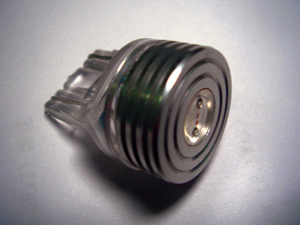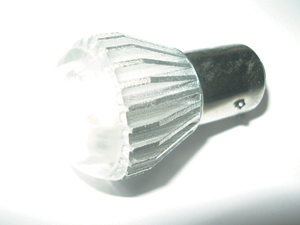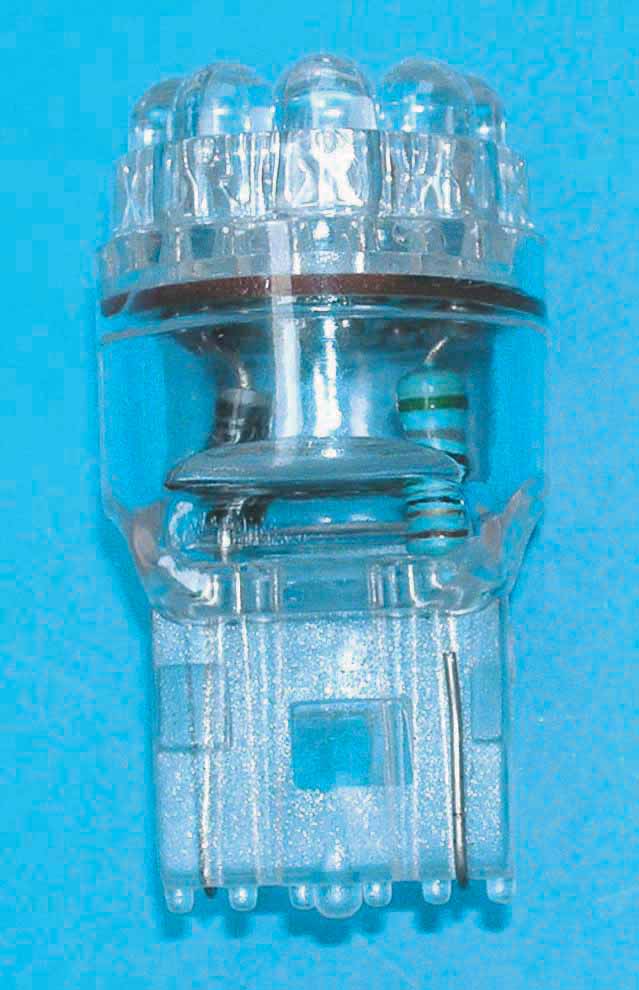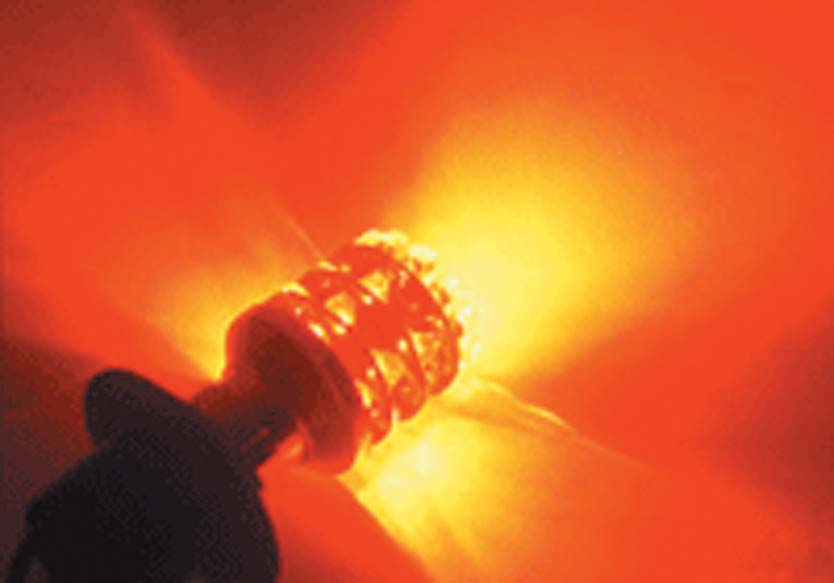Lights Shine Promising Path for Growth of LED Auto Lamp Market
2008/04/22 | By CENS | WEI WANG LIGHT BULBS CO., LTD.A light emitting diode (LED) is an III-V semiconductor device that can convert electrical energy into visible light, a phenomenon called electroluminescence (EL). In recent years, labs have been fine-tuning this device to the point now that it is used with ever more frequency in the manufacture of auto lamps.
Global demand for LED auto lamps is estimated to surge past US$450 million this year, up from about US$300 million in 2005, US$236 million in 2004 and over US$200 million in 2003.
And it's no wonder. Energy conservation, long life span, zero maintenance, eco-friendliness, and easy operation have made semiconductor, or solid-state, lighting such as LED the darling among lighting technologies emerging to dethrone the incandescent and fluorescent light bulb.
The outlook for LED lighting is bullish. Market watcher BCC Research estimates that global market for high bright LED will hit US$10.6 billion in 2011, up from 2006's US$6.6 billion and nearly double 2005's US$5.8 billion. Impressed by the bright future, industrially advanced countries including the United States, Japan, European Union and South Korea are introducing advanced technologies and industry standards in hope of snatching up a dominant chunk in the rising market.
Although China is a late entrant in the market, it has been quick on its feet. The Ministry of Science and Technology, according to a guideline for mid- and long-term development of national sciences and technologies, has injected RMB350 million (US$50 million at US$1:RMB7) into 863 LED-lighting projects and overcome several bottlenecks to introduce some crucial LED technologies, including white LED devices, GaN epitaxy wafers, blue laser generators and GaN substrates.
The illumination theory applied to LED lamp differs totally from that for traditional lighting sources. LED lamps also have different properties from those of traditional lamps, rendering the industry standards for measuring traditional lamps useless on LED lamps. In light of the standard gaps, China's Ministry of Science and Technology and Ministry of the Information Industry are intensively working on LED standards to create a healthy environment for competition.
China has made considerable progress in developing LED-lighting technology and its industry standard has also been moving steadily ahead.
What's Not to Like?
In many respects, LED lamps represent a sea change over older lighting technology. Most importantly, they are energy misers, slashing electricity use by as much as 80% compared to tungsten light bulbs. Lighting bills will fall and electric vehicles will run longer as this device becomes more ubiquitous in daily life.
LED lamps also offer dramatic improvements over their tungsten counterparts in terms of life span. LED bulbs have a life of 20,000 to 50,000 hours before they begin to fade, long after traditional lamps have bit the dust. The day may soon arrive when cars will be retired with their original headlamps.
Lighting efficiency is another advantage of LED. When plugged in same type of power factor, LED lamps give off a higher luminous flux than do traditional lamps. The lamps also light up quickly, which in driving situations can mean greater safety.
The earth, too, can breathe easier thanks to LED lighting. LED lamps contain no mercury, emit no radiation, and their power savings mean less coal and gas burned to keep them going.
Car designers also welcome the arrival of LED bulbs since their Lilliputian sizes allow greater design flexibility and leave more space for other devices.
As if all of that weren't already enough, LED lamps have an impressive level of shock resistance as a solid-state light source.
As a result, LED lights are moving up from their low position as car status indicators and literally entering the spotlight, or headlight at least, on luxury sedans. Mid-market car models are also relying increasingly on LED lighting in brake lights, taillights and turn lights.
Manufacturers in China, many of them Taiwanese transplants, can now produce nearly any type of LED auto lamp, except LED headlamps. With a helping hand from government policies and the protection of patents registered overseas, new entrants in China's LED auto-lamp industry look ahead to bright prospects indeed.
Ramping Up
Founded in 1981 in Taiwan, Wei Wang Bulbs Co., Ltd., a manufacturer of high-quality car lamps and motorbike lamps, opened a branch in the mainland in 1999 and established its LED business unit in the following year. Today, the company produces all types of LED auto lamp except headlamps.

With over 20 years of experience in the auto-lamp industry, the company knows how to design auto lamps that meet the real-world needs of the market.
Although a relatively late entrant to the LEF-lamp business, Wei Wang has been rapidly catching up with is a strong LED R&D team composed of seven engineers at its mainland China factory and four technicians at its Taiwan headquarters.
The team is personally led by the company president, Wei-han Chen. Chen is a senior R&D engineer in the LED industry. "Chen's expertise in LED technology is the major factor behind the company's success in identifying the parameters crucial for LED lighting fixtures in the manufacturing process, such as thermal dissipation and packaging materials," says Catcher Ke, the company's product manager. "He's very conscientious about each step of the manufacturing process, and this ensures the quality of our products," Ke adds.

In June last year, the company's LED unit at its mainland factory imported automated flow production lines and automated inspection equipment from Taiwan. "The automatic machines have doubled our output efficiency and kept costs down. We have also been able to retract 80% of our outsourcing work," says Ke
Ke says his company now has a complete set of quality-inspection machines, including an optical spectrum analyzer, automatic wave soldiering machine, and fatigue testing system. "Before we installed these automatic inspection machines, it usually took us about a thousand hours to test new materials. The machines have enabled us to halve that time to only 500 hours and test more materials at the same time," Ke notes.
Thermal dissipation has been a problem plaguing high-power LED lamps, Ke stresses. "To address this problem, we normally use copper or aluminum dissipation solution in our high-power lamps. The two metals perform well in thermal dissipation," he says.
Ke stresses that technically LED headlamps are viable, but the costs are very high given the ultra high brightness the emitters are required. "That's why we are still making auxiliary lamps," he explains.
The company delivered two million LED auto lamps last year and projects shipment for this year to increase 10%. "Our products mostly go to European Union and the United States. They are also RoHS compliant," Ke stresses.
Bright Prospects
Dongguan ChengLi Electronics Co., Ltd. designs, develops, manufactures and markets a variety of automotive-use LED lamps, including turn signals, decorative lamps, tail lamps, brake lights, indicators, dashboard lights, wind-power lights, and under-car lights.

"Although ChengLi was just opened in 2006, we have a number of experienced specialists in application-electronics and intelligent-control fields. They are able to design software programs that allow LED lamps to give off lights of various colors," boasts Jimmy Lee, the company's sales manager.
Lee notes that although LED lamps usually begin to dim after 20,000 to 50,000 hours of use, the lamps' average life span is still far longer than that of traditional lamps. "Lamp replacement and maintenance may not be necessarily for cars equipped with LED lamps, barring accidental damage of course," Lee says. "Although LED lamps are more expensive than traditional lamps, they pay for themselves in energy savings and longer life spans," he adds.
Lee says his company has tooled its production lines with automatic machines that have significantly boosted the company's output efficiency. "We have increased output of various LED lamps including auto lamps to a large extent mostly thanks to our automated production line, efficient quality-inspection equipment, and the ISO9001-2000 quality-management system," Lee notes.
Quality Conscious
Shenzhen Everyday Lighting Technology Co., Ltd. designs, develops, and manufactures LED lighting fixtures including auto lamps. LED auto lamps, including turn signals, brake lights, reversing lights, and roof lights, now constitute 20-30% of the company's total output.

"We strictly controlled the quality of outsourcing semi-finished parts and ask our suppliers to control their defect ratio within 0.3%," says company sales director Yuzhong Xu. "We also use an array of inspection instruments to test every LED emitter for their performance in luminous flux, resistance to brightness depreciation and resistance to static interference," he adds.
Xu says his company is CE and RoHS certified, attesting to its commitment to making high-quality and eco-friendly products.
Xu says that his company's output of LED auto lamps is rising fast. "Our output of brake lights installed with 36 LED emitters, for instance, has surged to 4,000 sets from 1,000 sets a day," he says.
Xu says his company's LED auto lamps consume less energy than traditional lamps, yet deliver the same illumination quality. He says that Europe, the United States, Japan, and Southeast Asia are the company's major export destinations, together accounting for 60-70% of its sales. "We've received orders from European buyers for LED auto lamps almost every month," he reports.

